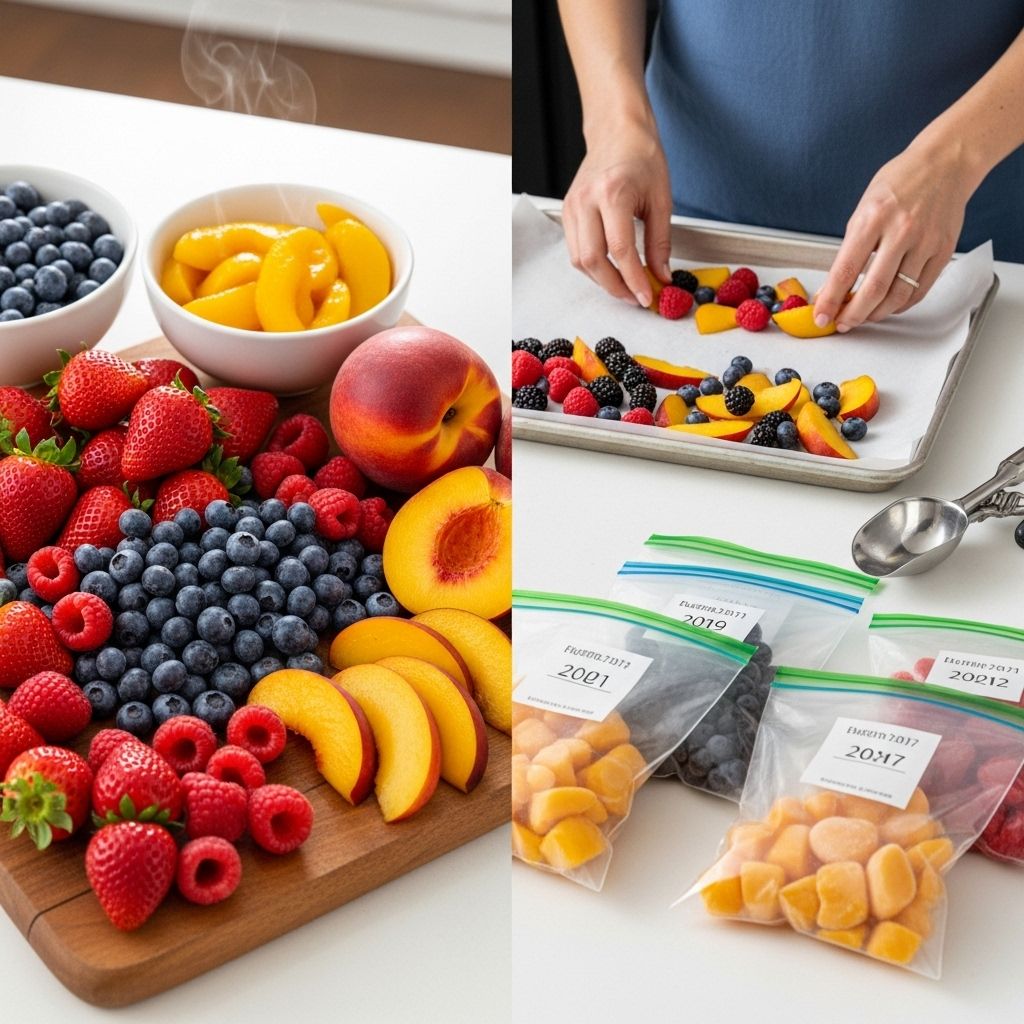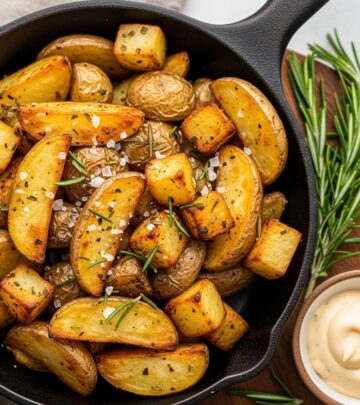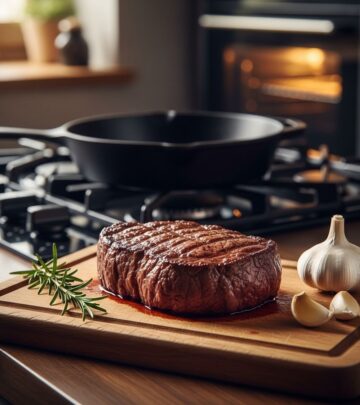How to Freeze Summer Fruit for Peak Freshness and Flavor
Preserve juicy flavors and firm texture in frozen fruit all winter.

Whether you’ve returned from the market with armfuls of berries or found your countertop overflowing with sun-warmed stone fruit, freezing is the smartest way to capture summer’s bounty at its peak and enjoy it well past the final heatwave. But not all fruits freeze equally — and knowing what’s best for the freezer (and how to prep it) will ensure your midwinter smoothies, jams, and pies taste fresh, not mushy.
Why Freezing Fruit Works (and What Can Go Wrong)
At its core, freezing fruit preserves it by halting spoilage and decay, but the journey from ripe and juicy to frozen and firm can have a big impact on quality. Fruit is mostly water locked in sturdy plant cells. When frozen slowly, water expands into large ice crystals, which rupture these cells and lead to a soggy, watery mess upon thawing. Quick-freezing, however, forms smaller crystals and keeps more cell structure intact, giving closer-to-fresh texture and less pooling juices on defrosting.
- Fruit with high water content (like melons or citrus) tends to go mushy after thawing; these are best pureed before freezing.
- Quick-freezing (flash freezing) is key for berries, stone fruit, and sliced fruit to avoid clumping and maximize texture.
- Proper storage protects against freezer burn and off-flavors.
Which Fruits Freeze Well — and Which Don’t?
Not every fruit is destined for the freezer. Here’s a quick guide to what works, what doesn’t, and creative ways to make the most of any fruit before it turns.
| Fruit | Best Freezing Method | Texture After Thawing | Best Uses |
|---|---|---|---|
| Berries (strawberries, blueberries, etc.) | Flash freeze whole or sliced | Soft, juicy | Smoothies, pies, baking |
| Stone fruit (peaches, nectarines, plums) | Slice, remove pits, flash freeze | Softer, holds shape | Crisps, sauces, ice cream |
| Bananas | Peel, slice/chunk, flash freeze | Very soft | Smoothies, baking, ice cream |
| Melons & Citrus | Puree & freeze in cubes | Watery, breaks down | Popsicles, granitas, cocktails |
| Grapes | Whole, flash freeze | Firm when eaten frozen, soft when thawed | Frozen snacks, edible ice cubes |
Step-by-Step Guide: How to Freeze Summer Fruit
- Choose the Right Fruit
- Select ripe but not overripe fruit. Avoid bruised or mushy pieces: these textures will only worsen after freezing.
- For best results, freeze fruit at its peak.
- Wash and Prep Thoroughly
- Gently rinse fruit under cool water and dry completely — moisture creates ice on frozen fruit, leading to freezer burn.
- Remove stems, pits, and peels as needed. Cut larger fruit into slices or bite-sized pieces so they freeze quickly and evenly.
For those who love smoothies and baking, mastering the process of freezing bananas can be a game changer. Our complete guide on how to freeze bananas will show you the best methods to retain their flavor and texture. Whether you're making banana bread or a post-workout shake, knowing how to freeze them properly can enhance your culinary creations. - Flash Freeze for Texture and Separation
- Arrange prepared fruit in a single layer on a baking sheet lined with parchment paper. Keep pieces from touching to prevent clumping.
- Place the baking sheet in the freezer uncovered. Freeze until solid; this takes 1–2 hours for berries, a little longer for larger pieces.
- Pack Then Store Properly
- Transfer frozen fruit to airtight containers or freezer bags. Remove as much air as possible for best storage.
- Label with the type of fruit and date. Most frozen fruit maintains quality for up to a year, though best used within 6–8 months for optimal texture and taste.
Special Tips by Fruit Type
- Berries: Small berries freeze whole but slice larger strawberries. Don’t wash until just before freezing, then dry thoroughly.
- Bananas: Never freeze in the peel; peel and slice or chunk first. Use directly from frozen in baking or smoothies.
- Stone Fruit: Remove pits, cut into wedges or chunks. Optionally, toss with a little lemon juice to prevent browning.
- Melons and Citrus: Puree and freeze in ice cube trays for smoothies, drinks, and frozen desserts.
- Grapes: Eat frozen for a cool snack or use as ice cubes in drinks. Thawed grapes lose their firm texture.
Preventing Mushy or Icy Results: Common Mistakes
Freezing quickly and storing well is only part of the puzzle. Here are other ways to avoid disappointing texture and loss of flavor:
- Don’t freeze fruit that’s already overripe, squishy, or moldy. Freezing won’t reverse spoilage; it just stops it in place.
- Avoid overcrowding the tray during flash freeze. This prevents clumps and ensures quick, even freezing.
- Skip glass jars unless they’re freezer-safe. Fruit expands as it freezes, which can crack jars.
- Use containers designed for freezing. Heavy-duty freezer bags or airtight plastic boxes work great. Squeeze out excess air to avoid freezer burn.
- Date everything. Older fruit may develop off-flavors with time, even if technically safe to eat.
Creative Uses for Frozen Summer Fruit
Frozen fruit excels in recipes where texture is less crucial than flavor, sweetness, or juiciness. Try these easy options:
- Smoothies: Use berries, bananas, and stone fruit straight from the freezer for thick, creamy blends.
- Baking: Substitute frozen fruit for fresh in pies, crisps, muffins, and cakes. Toss with a little flour or cornstarch to absorb excess juices.
- Jams and Compotes: Cook frozen fruit slowly for spreads or toppings on yogurt and desserts.
- Frozen snacks: Enjoy frozen grapes or berries as a healthy chilled treat.
- Popsicles and granitas: Pureed frozen fruit is ideal for frozen desserts.
Defrosting and Thawing: Tips for the Best Texture
- Thaw only what you’ll use. Return any unused frozen fruit to the freezer promptly.
- Thaw in the fridge for best texture, especially for larger pieces that could get mushy if left at room temperature.
- Avoid microwaving unless you’re preparing a sauce or baking; microwaves can make fruit lose more liquid and become soft or rubbery.
- For smoothies and certain desserts, no thawing is required — blend or cook the fruit from frozen.
Freezing Fruit FAQs
Can all fruits be frozen?
Most fruits freeze well but those with extremely high water content, like watermelon and citrus slices, are best pureed before freezing to avoid watery, mushy results.
How long can I store frozen fruit?
For best quality, use within 6–8 months; up to a year is safe. Texture and flavor begin to degrade gradually after that.
Should I add sugar or syrup before freezing fruit?
Sugar is optional — it can help retain shape and color, especially with delicate berries, but isn’t necessary unless storing for use in syrups or desserts where sugar is wanted.
What’s the best way to avoid freezer burn?
Freeze quickly, use airtight packaging, and remove as much air as possible before sealing. Avoid repeatedly opening bags and exposing fruit to air.
Can I freeze mixed fruit together?
You can, but freezing fruits separately preserves their texture and flavor best. Mix only once fully frozen to avoid clumping and uneven results.
Final Tips for Freezing Success
- Flash freeze in single layers for best texture.
- Label and date your containers so you can rotate your stash for best quality.
- Be creative — purée extra fruit for smoothie packs, freeze in cubes for drinks, or use straight from frozen in recipes that don’t rely on perfect texture.
- Remember: Freezing halts ripening, but it doesn’t improve fruit. Only freeze what’s truly ripe and delicious to start with for best winter eating.
By using these methods, you can savor the sweetness of local fruit long after summer fades, transforming what might become waste into year-round treasure and deliciousness.
Read full bio of Sneha Tete












